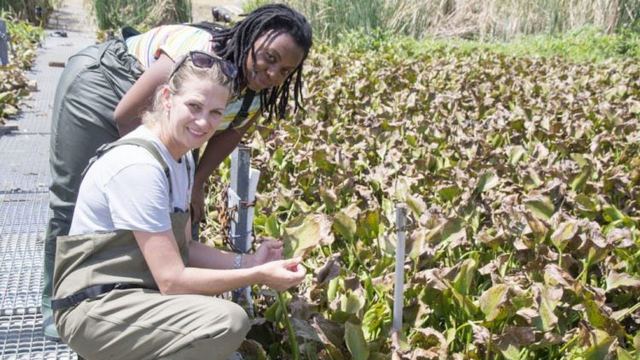
Billions of tiny insects are currently responsible for rapidly destroying the hyacinth on the Hartbeespoort Dam and scientists are of the opinion that herbicides have not been sprayed on the dying water plants.
According to Professor Julie Coetzee from the Centre for Biological Control (CBC) at Rhodes University, other plants amongst the hyacinth would also be dead if herbicides have been sprayed. “If a herbicide has been sprayed, the plants would have sunk by now. The stems of the plants would not be green either. In addition, the control agents (bugs) would have died too because the herbicides and their additives are toxic to the insects. We have found no evidence of a herbicide so far.” Other scientists agree with this.
“I know that there is a lot of speculation around the alleged spraying of the water hyacinth plants with various theories as to why the plants were sprayed. People find it hard to believe that the browning of the plants could actually be due to biological control agents. I also understand that there is scepticism around my team’s presence at the dam. While we don’t have evidence that the plants weren’t sprayed, there is so much evidence pointing towards biological control, as opposed to herbicides. The damage to the plants is what we see in our greenhouse tunnels, and at other sites where Megamelus scutellaris planthopper has been released, and has in fact controlled water hyacinth in the absence of any other intervention,” Prof Coetzee said.
Currently six different kinds of insects can be found on the hyacinth but most of the success is ascribed to the planthopper that has been continuously and intensively introduced since last year.
Biological control agents in the form of plant specific bugs have been instituted on the Hartbeespoort Dam since the 1980’s but due to periodic herbicide application, their population has been inhibited. Professor Coetzee added said: “We believe that the lack of herbicide application over the last 2.5 years on the dam has allowed the biocontrol insects to build up their populations to a level where we are now noticing plant death. People are doubtful that the insects could really damage the plants to this level, but every single plant that I have picked up has had thousands of insects on them.”
Professor Coetzee and her team at the CBC embarked on a mass release campaign over the last year, together with Pecanwood College and Mountain Cambridge School, in consultation with Harties Foundation and other stakeholders around the dam, releasing tens of thousands of the planthopper monthly. They continue to monitor these populations monthly. Water hyacinth is an invasive non-native weed from South America, that has been on Hartbeespoort Dam since the mid 1960s. There has been a long history of control of this weed including herbicide application, mechanical and manual removal and biological control. Whilst all of these control interventions can be effective, biological control is considered the most sustainable and environmentally friendly.
“The two most noticeable insects are the Neochetina weevils, and the water hyacinth plant hopper, Megamelus scutellaris, which come from South America too. These insects have been thoroughly studied in South Africa, and elsewhere, including the USA and Australia, over many years to make sure that they are safe (i.e. only feed on water hyacinth) and effective in controlling water hyacinth,” she added.
She said biological control is a natural process and a long term but sustainable solution. “Biocontrol aims to reunite invasive species with the natural enemies. The results on the dam are already significant. And now that the plants are dying we have seen a drop of 3% coverage from 13% to 10% in only the past week.” Although the bulbs of the hyacinth are currently still green, it is full of biological damage which will cause the plants to sink and die.
Asked what will happen once the hyacinth has disappeared, she explained: “The water hyacinth will never completely disappear from the dam. Some should remain on the shores. The biocontrol insect populations will also decrease as the plants die, but should keep the small populations of the plants in check. These insects can only feed and reproduce on water hyacinth, no other plants will be affected.”
However, the hyacinth might recover in the spring as a result of a cold winter and high nutrients, as well as seeds in the sediment, but CBC’s continual release of insects and monitoring will ensure that the insect populations build up faster than they would on their own.
